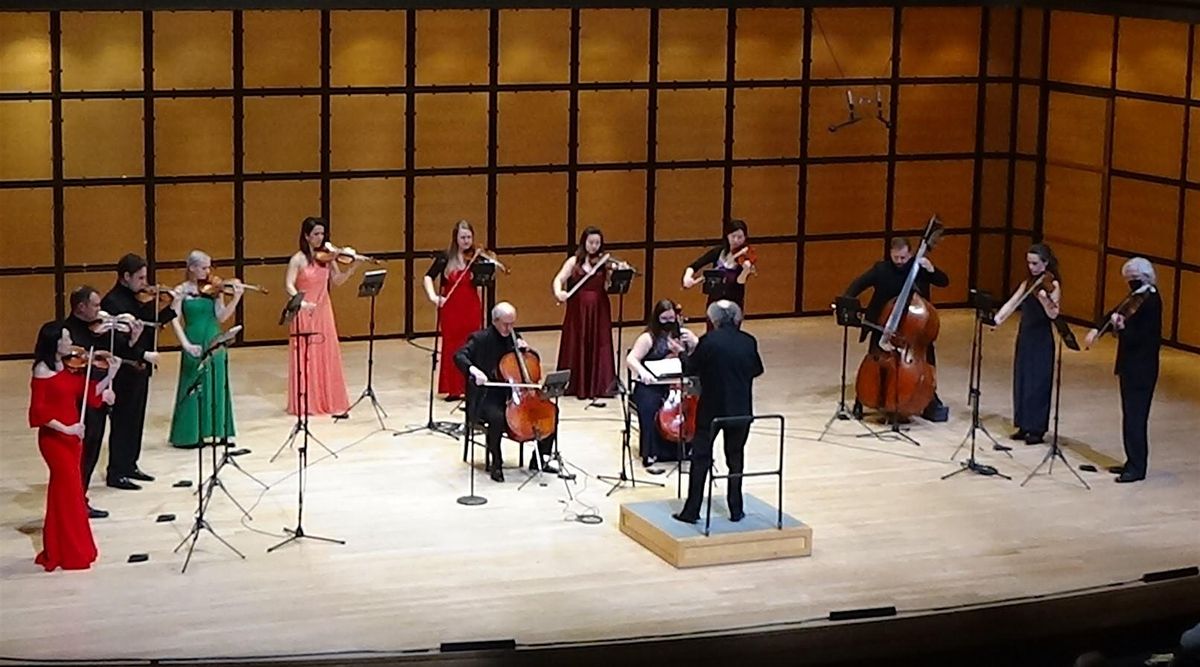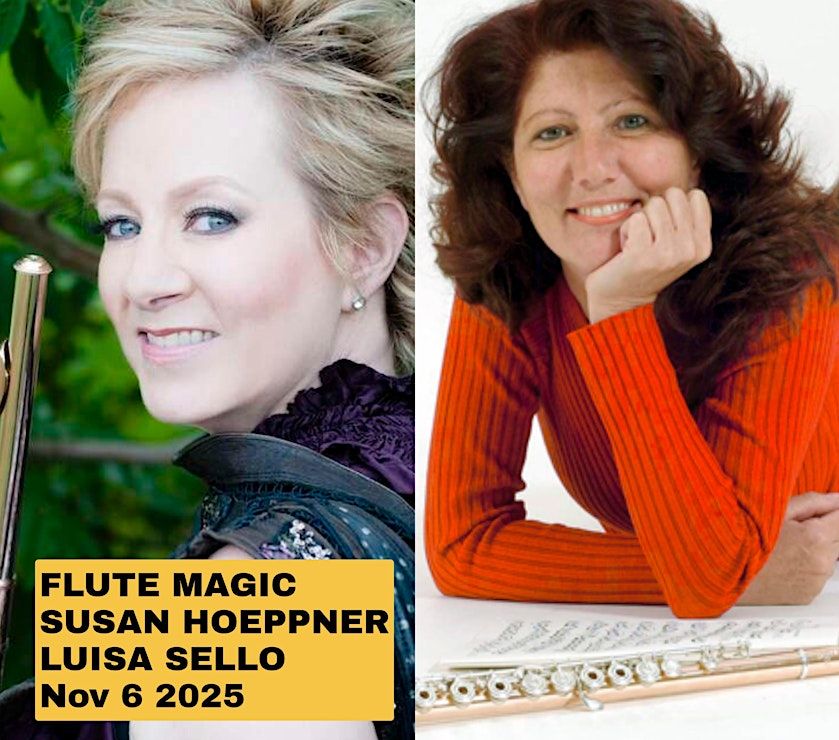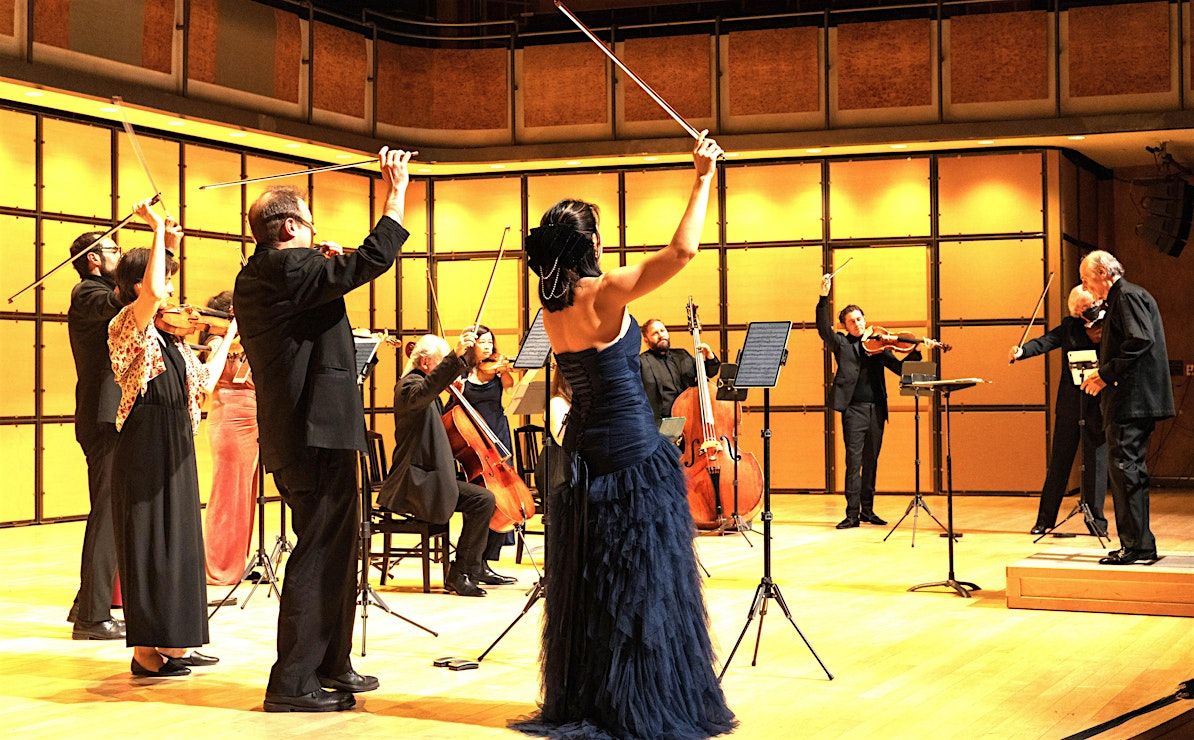
About this Event
Thursday, November 6, 2025, 7:30 pm, Trinity-St. Paul's Centre, 427 Bloor St. West
FLUTE MAGIC Vivaldi | Ho | Janacek
Two star flutists team up to premiere Alice Ho’s Celestial Concerto and sparkle
in a Vivaldi favourite; the orchestra shines in Romantic masterpieces
SINFONIA TORONTO / NURHAN ARMAN Conductor
LUISA SELLO / SUSAN HOEPPNER Flutists
Program
GLAZOUNOV Theme and Variations for String Orchestra, Op.97
VIVALDI Concerto for 2 Flutes in C major
ALICE PING YEE HO Celestial Concerto for 2 Flutes and Strings world premiere
VIVALDI Sinfonia in G major, RV 146
JANACEK Suite
Alice Ping Yee Ho's 'Celestial Concerto' is commissioned by Sinfonia Toronto and supported by the Canada Council for the Arts and the Ontario Arts Council.


PERFORMER BIOGRAPHIES
Susan Hoeppner - Canadian flutist Susan Hoeppner is an international soloist, recitalist and chamber musician, with appearances in North and South America, Europe, Japan and China. Ms. Hoeppner has performed as soloist with orchestras around the world. Her many recordings are on iTunes, Spotify, Amazon, and on labels, including Marquis Classics, EMI, Centrediscs/Naxos and Grammophon BIS.
A graduate of The Juilliard School, Ms. Hoeppner offers masterclasses and teaches at the Glenn Gould School, The Taylor Academy of the Royal Conservatory, and at the University of Toronto. During the summers she teaches at Domaine Forget de Charlevoix in Canada and at the Campus Internazionale della Musica d’Arte in Italy.
Luisa Sello, Flutist - Italian flutist Luisa Sello has performed as a recitalist and chamber musician throughout Europe, the United States, Canada, South America, Eastern Europe and in many Asian countries. Luisa Sello has been a guest of the Wiener Symphoniker, Salzburger Krammerorchester Orchestra of the “Teatro alla Scala” in Milan under Riccardo Muti. A visiting professor at the University of Music of Vienna, she has been invited to give master classes at the universities of Koln, Aachen, Moscow, Madrid, Miami, Tallin, Zagreb, Peking, Shanghai and Buenos Aires.
Luisa Sello has a Doctor of Musical Arts degree from Italy and Paris where she studied flute and contemporary and Baroque performance practice. She has studied in Paris with Raymond Guiot, at the Accademia Chigiana with Severino Gazzelloni and at the Académie Internationale of Nice with Alain Marion.
Sinfonia Toronto, now in its 27th season, has toured twice in Europe, in the US, South America and China, receiving glowing reviews. It has released six CD’s, including a JUNO Award winner, and performs in many Ontario cities. Its extensive repertoire includes all the major string orchestra works of the 18th through 21st centuries, and it has premiered many new works. Under the baton of Nurhan Arman the orchestra’s performances present outstanding international guest artists and prominent Canadian musicians.
Maestro Nurhan Arman has conducted throughout Europe, Asia, South America, Canada and the US, returning regularly to many orchestras in Europe. Among the orchestras Maestro Arman has conducted are the Moscow Philharmonic, Deutsches Kammerorchester Frankfurt, Filarmonica Italiana, St. Petersburg State Hermitage Orchestra, Orchestre Regional d’Ile de France, Hungarian Symphony, Arpeggione Kammerorchester, Milano Classica and Belgrade Philharmonic.
PROGRAM NOTES
Theme and Variations for Strings, Op. 97 by Alexander Glazounov (1865-1936)
Alexander Konstantinovich Glazunov was active during the late Romantic period. He served as director of the Saint Petersburg Conservatory from 1905 to 1928; the best known student to attend under his tenure during the early Soviet years was Dmitri Shostakovich.
Glazunov exerted significant influence by successfully reconciling nationalism and cosmopolitanism/internationalism in Russian music. He was the direct inheritor of Mili Balakirev's nationalism, but he leaned towards Alexander Borodin's majesty and classical architecture. He absorbed and integrated many other influences as well, including Rimsky-Korsakov's orchestral virtuosity, Tchaikovsky's lyricism and Taneyev's contrapuntal techniques. The next generation of composers such as Prokofiev and Shostakovich considered his music old-fashioned, but respected him as a composer with a stabilizing and encouraging influence during a time of transition and adversity.
This composition demonstrates Glazunov’s talent for writing gorgeous melodies and his skill in creating effectively contrasting variations for the many textures available within a string orchestra. His initial theme provides a melodic through-line for six variations, each with a different tempo and character.
Concerto for Two Flutes in C Major, RV 533 Antonio Vivaldi (1678-1741)
Vivaldi’s Concerto for Two Flutes in C Major, RV 533, composed around 1730, is the only concerto he wrote specifically for two transverse flutes rather than recorders, which were more common during the Baroque era. This choice reflects the growing popularity of the transverse flute in both secular and sacred music in the 18th century.
Though Vivaldi wrote nearly 50 concertos featuring two soloists this is the only one for two flutes. Some believe the transverse flute was more acceptable in religious settings, such as the orphanage where Vivaldi taught. The Church, following ancient writings, had come to view the recorder as having immoral associations. Vivaldi likely began composing for the transverse flute in the late 1720’s.
Vivaldi’s decision to write for two transverse flutes was likely influenced by the instrument’s rising popularity, encouraged by a visit from the famous flutist Johann Joachim Quantz in 1726 and the reappointment of Ignazio Sieber as flute master at the Ospedale della Pietà in 1728. Both events may have encouraged Vivaldi to explore the transverse flute’s potential.
The concerto follows Vivaldi’s typical three-movement fast-slow-fast format. The first movement Allegro molto is bright and energetic. It follows the ritornello form, where the full orchestra presents the main theme before the soloists take turns playing it. The two flutes often echo each other, then move in parallel. The second movement Largo provides a slow, lyrical contrast to the lively outer movements. Like many of Vivaldi’s slow movements, it features expressive solo melodies over a soft string accompaniment, allowing for more emotional introspection. The final movement returns to a quick Allegro tempo, continuing to showcase playful interaction between the flutes and the orchestra, with energetic exchanges and a return to themes introduced earlier in the concerto.
Today this concerto is recognized for its bright, cheerful character and the engaging dialogue between the two flutes. It showcases Vivaldi’s ability to create energetic musical conversations and highlights the expressive, ethereal qualities of the transverse flute. It is a lovely example of Baroque concerto writing and Vivaldi’s interest in innovation.
Celestial Concerto for Two Flutes and Strings by Alice Ping Yee Ho (1960) World premiere
Notes from the composer:
The Celestial Concerto for Two Flutes and Strings was commissioned by Sinfonia Toronto for Susan Hoeppner and Luisa Sello, with the generous support of the Canada Council for the Arts and the Ontario Arts Council. It is a three-movement work inspired by the mythologies of three mystical birds: Italy’s healing Caladrius, China’s radiant Golden Crow, and the powerful Thunderbird from Indigenous Canadian traditions. While rooted in distinct cultures, each bird symbolizes transformation, resilience, and a connection to the divine -qualities that form the thematic core of this concerto.
The piece is also a personal reflection on the struggle and perseverance of women throughout history. These mythologies, often overlooked in their connotations of feminine power and regeneration, resonate deeply with my own artistic path and pursuit of renewal.
Scored for two flutes and strings, the concerto takes full advantage of the flutes’ expressive range - capable of both lyricism and brilliance - and the shimmering textures of the string orchestra. The pairing of two soloists creates rich opportunities for dialogue, contrast, and unity, embodying the ever-shifting spirit of these mythic creatures. It is a form particularly well-suited for exploring themes of duality, transformation, and shared strength.
The first movement, The Caladrius, evokes the pure white bird from ancient Roman lore, whose healing powers were believed to absorb illness. Here, graceful lines, transparent textures and classical European gestures convey a sense of ethereal beauty and restoration.
The second movement, The Golden Crow, is rooted in Chinese mythology, where the crow symbolizes the sun. This movement radiates heat and light through intricate patterns, modal melodies, and rhythmic momentum, blending Eastern and Western musical ideas.
The final movement, The Thunderbird, draws from Indigenous stories where the bird commands thunder, lightning, and transformation. It incorporates contemporary techniques such as beatboxing and group vocalization to suggest primal energy and ritual, offering a powerful close to the work.
Through the combined artistry of flutists Susan Hoeppner and Luisa Sello, and the vibrant support of Sinfonia Toronto under Nurhan Arman, Celestial Concerto emerges as a celebration of cultural beauty, resilience, and the unyielding human spirit.
Sinfonia in G major, RV 146 by Antonio Vivaldi (1678-1741)
Vivaldi’s Sinfonia in G Major, RV 146 is a lively, energetic piece that highlights the composer’s skill. It follows the period’s typical three-movement fast-slow-fast structure, showcasing Vivaldi’s signature rhythmic drive and melodic creativity.
The first movement Allegro is bright and animated, featuring strong contrasts in dynamics and rhythm. The second movement Andante e sempre piano is a slow movement that provides a gentle contrast to the opening movement. Sempre piano directs the musicians to play softly throughout, creating a calm and introspective mood. The movement is a fast and spirited Presto, filled with rapid passagework and lively rhythms. It brings the sinfonia to an exciting, joyful conclusion.
This sinfonia was composed as the overture to Vivaldi’s opera La fede tradita e vendicata, “Faith Betrayed and Avenged.” During the Baroque period many operas began with a sinfonia that served as an overture, introducing musical themes and setting the mood for the performance.
Suite for Strings by Leoš Janáćek (1854-1928)
Janáćek’s first instrumental works, the Suite, from 1877, and Idyll, from 1878, were both composed for string orchestra. He directed the premiere of the Suite in December 1877 in Brno, the capital of Moravia. The unabashedly bright and youthful work’s six movements show Janáćek’s musical heritage and inspiration, the Czech national style founded by Smetana and exalted by Dvořák.
Dvořák’s influence in particular is evident in the striking three-chord opening of the first movement Moderato and the free-spirited lyricism that follows. The first Adagio displays brooding Romantic chromaticism and tone-colours in its scoring for muted violins and violas alone. The third movement Andante is classically simple, clearing some auditory space before the driving fourth movement Presto. A second short Adagio features the cellos and doublebass and sets the stage for a concluding Andante for the full ensemble which again recalls Dvořák, punctuating an engaging melodic line with a pointed dotted-rhythm motif.
Event Venue & Nearby Stays
Trinity-St. Paul's United Church and Centre for Faith, Justice and the Arts, 427 Bloor Street West, Toronto, Canada
CAD 25.57 to CAD 54.76












